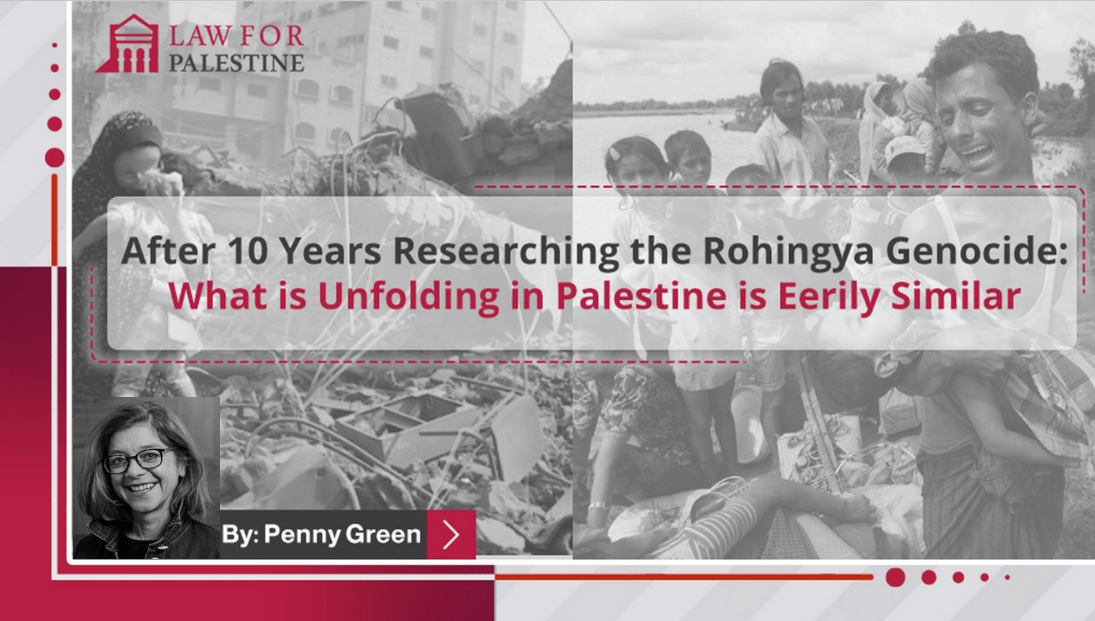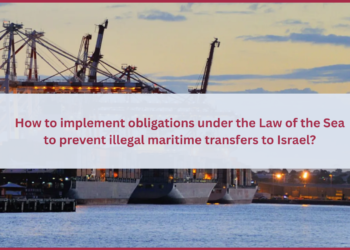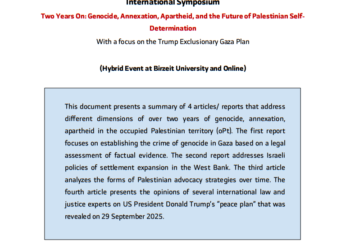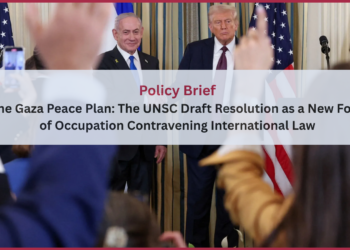After 10 Years Researching the Rohingya Genocide: What is Unfolding in Palestine is Eerily Similar
By: Penny Green *
Professor of Law and Globalisation at Queen Mary University of London
When I began researching the Rohingya genocide with my colleagues in 2012, there were between 1.2 and 1.4 million Rohingya living in Rakhine state in the west of Myanmar. That figure, is now below 300,000, and those who remain live in a state of fear and ‘bare life’. In central Rakhine 150,000 Rohingya languish in squalid detention camps, and thousands of others are confined to desolate ghettos or prison villages following genocidal violence against their communities in 2012. Northern Rakhine state became a Muslim graveyard in 2017 when the vast majority of Rohingya who lived there were forcibly expelled or killed. Those Rohingya who fled live in the world’s largest refugee camp in Bangladesh and remain unable to return to their destroyed villages. Many scholars, activists, and human rights practitioners now define the nature of the brutal state and social violence levied against the Rohingya as a genocide. But in 2014 only the International State Crime Initiative (ISCI 2015) and scholars Zarni and Cowley (2015) identified and warned that a genocide was unfolding, and that the annihilation phase would surely follow. Global human rights organisations, trapped within a limited international legal paradigm, were in fact hostile to the designation of genocide until the mass violence and forcible evictions of 2017.
The Rohingya genocide effectively began with a number of pogroms in the 1970s (building on divisions created by the former British colonial power) and remained in its early stages through the 1990s. The scale of the genocidal process escalated in 2012, as the State moved to implement de jure forms of discrimination, apartheid and dehumanisation. In 2015 the state introduced its notorious Race and Religion Protection Laws, designed to inhibit and stigmatise the culture, practices, and lifestyles of Myanmar’s Muslim population, but specifically targeted at the Rohingya. Alongside these structurally discriminatory laws, there was a state-sponsored hate campaign against the Rohingya, operationalised by ultranationalist sections of civil society to engage the population in its ethnonationalist campaign. Dehumanization took the form of deeply violent genocidal rhetoric. The Rohingya were described as sub-human, people ‘who eat their own kin’, ‘as ugly as ogres’, ‘dogs’, ‘maggots’, ‘rapists’, terrorists and illegal immigrants. This language was then adopted by the dominant community and impacted on who should fall within the state’s sphere of moral obligation. Ultranationalists took to social media to suggest the Rohingya be fed to pigs, shot, or exterminated.
Having studied state crimes against both the Palestinians and the Rohingya, what happened in Rakhine state Myanmar is axiomatically similar to what is unfolding in Palestine today.
Genocide embodies both the intention and attempt to annihilate, in whole or in part, a group of people based on their religion, their nationality, ethnicity or their race. Genocide is not simply an incident of spectacularized mass violence (although that may also be present), but rather a process which begins with ideological dehumanisation and ends in erasure In between and often occurring concurrently are litmus-testing forms of sporadic violence, the physical isolation of the target group through apartheid forms of segregation and the systematic weakening of that group. Genocide may take place over many years and as with both the Palestinians and the Rohingya over decades. Unfortunately human rights organisations and most scholars only start talking about the possibility of genocide at the annihilation stage.
Within genocidal processes, these isolated spaces enable the commission of violence with impunity, and the structural weakening of the target group. In Myanmar, all the resources essential to leading a purposeful life are unavailable to the Rohingya, including access to health care, adequate food and water, and stable shelter. The vast majority are now in enforced exile unable to return home.
In Gaza, Israel has implemented a total siege: no water, no food, no medical supplies, no fuel, no electricity, in the words of Israel’s Minister of Defense. This siege follows 16 years of Israel’s illegal blockade of Gaza which includes controlling and limiting all goods and individuals who enter and exit the strip, all the while undertaking repeated bombing campaigns in accordance with Israel’s “mowing the lawn” (perpetual war) doctrine with respect to the enclave. And across historic Palestine, Israel is now increasing its already very high level of repression against Palestinian citizens of Israel, while significantly ramping up IOF and settler violence in the West Bank.
Once the target group is systematically weakened, the next phase is mass annihilation. This can take place through mass killing, as is occurring in Gaza and previously transpired in Myanmar. But this annihilatory phase can also take place in the form of mass forced evictions. What is so striking to me is that the 1948 Nakba saw 750,000 of 1.4 million Palestinians forced to flee their homes and 15,000 Palestinians murdered, as part of a deliberate plan (Plan Dalet) to ethnically cleanse the land. In Myanmar, between 2017 and 2018, almost the same number were forced to flee (800,000) and between 10 and 20,000 were killed. And today, more than 1.5 million Palestinians have been violently displaced since October 7, while Israeli political and military leaders call for a repetition of the violence of 1948 on a scale to dwarf. the Nakba.
The Myanmar regime made clear its intention ‘to finish the job’ but with far less global publicity and international support than Israel enjoys.
‘The Bengali problem was a long-standing one which has become an unfinished job … The government in office is taking great care in solving the problem.’ [1]
What is unique about Palestine, however, is that leading political and military voices inside Israel have been utterly explicit and consistent about their intention to commit the annihilation phase of genocide.
Israel’s announcement that Gaza would be placed under ‘total siege’, cutting off water, food, electricity and medical supplies, amounted to a clear statement of intent to commit genocide against the Palestinian people by ‘deliberately inflicting on the group conditions of life calculated to bring about its physical destruction in whole or in part’ (Genocide Convention 1948, Article 2). The genocidal intention of the Israeli state is also embodied in statements by its leaders: IDF spokesperson Daniel Hagari declared that ‘the emphasis is on damage and not on accuracy’ when referring to Israeli aerial bombardments, while Netanyahu threatened to ‘flatten’ Gaza reducing it ‘to an island of ruins’. Knesset member, Arial Kallner, revealed ‘there is only one goal: Nakba [catastrophe]! A Nakba that would dwarf the Nakba of 1948’. When Defence Minister Yoav Gallant ordered a complete siege on Gaza he described Palestinians as ‘human animals’, and Israel’s President Isaac Herzog stated that there are no innocent civilians in Gaza, Israel’s declared intentions were again clear and explicitly genocidal.
Genocide is not a term that should be used lightly. But in Palestine, as in Myanmar, I am confident in naming the processes we’ve witnessed as genocide.
When these statements of resolve are combined with the catastrophic intensity of Israel’s bombardment of Gaza, and its 75-year history of settler colonial violence and apartheid discrimination against the Palestinian people I think we have sufficient evidence to demonstrate Israel’s intention ‘to destroy in whole or part’.
Genocide is not a term that should be used lightly. But in Palestine, as in Myanmar, I am confident in naming the processes we’ve witnessed as genocide.
A lesson from all genocides is that the international community of states, for strategic geopolitical reasons, will never act to prevent genocide; the international legal order will proceed cautiously and at a pace completely incompatible with prevention. To their shame many governments and global institutions remain in unjustifiable silence. This should not surprise us but it does mean that any impact on the future of this genocide will necessarily come from organised civil society.
We must therefore amplify our demands for an immediate ceasefire, an end to Israel’s occupation of Gaza and the West Bank, an end to international complicity, and support for the Palestinian BDS movement. In this way the real power in society, organised civil society has a chance to prevent the total annihilation of Palestine and Palestinians.
[1] Senior General Min Aung Hlaing, Commander-in-Chief of Myanmar’s armed forces, 1 September 2017, Nay Pyi Taw 1 September 2017[1]
* Penny Green is an British/Australian criminologist. She has been a Professor of Law and Globalisation (including 4 years as Head of the School of Law) at Queen Mary University of London since September 2014. Professor Green is known for her extensive exploration of Myanmar’s Genocide, and the question of Palestine and Israel’s state criminality, among other topics. She founded and is Co Director of the international State Crime Initiative.
** The views and opinions expressed in this article are those of the author/s and do not necessarily reflect the official policy or position of the Organisation.







